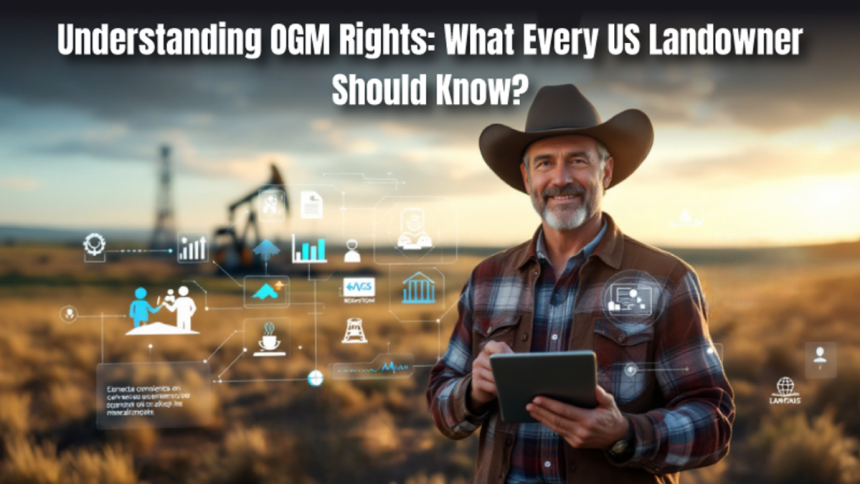In addition to appealing landscapes and farming prospects, owning land in the United States may also entitle you to significant OGM (oil, gas, and mineral) rights below the surface.
However, many landowners find it difficult to understand these rights since they are surrounded by technical and legal approaches. Understanding how OGM rights operate is significant whether you’re thinking about selling your mineral rights, leasing your land, or simply wanting to safeguard your property.
In this blog you will get essential information that all landowners need to be aware of to help you make smart decisions regarding your property and its undiscovered reserves. Let’s first understand what OGM rights are.
What Are OGM Rights?
We are all aware of the several rights that the US government offers. OGM rights are among the most important of those rights. Oil and gas mineral rights are referred to as OGM. The ownership rights of minerals, including oil and gas, that are located beneath a property’s surface are referred to as OGM rights.
The mineral owner is empowered to discover, extract, and profit from the minerals thanks to these rights. Anyone working in the oil and gas sector or thinking about buying or selling OGM rights has to understand the operation of these rights, what individuals usually do with them, and how they are valued.
Surface rights, which deal with the ownership and use of land above the surface, are distinct from mineral rights related to oil and gas. OGM and surface rights may occasionally be owned by the same person or company, while other times the subsurface rights may be separated from the surface owner and held by a distinct person, business, or organization. Multiple owners with different interests are possible because mineral rights and surface rights are separated.
For example, a landowner might sell the land but keep the oil, gas, and mineral (OGM) rights. This can cause problems if the new landowner and the mineral rights owner disagree on how the land should be used.
How Do OGM Rights Work?
Buyers can get OGM rights through a lease agreement with the property owner or by purchasing them directly. In a conventional lease, the lessor (mineral rights owner) receives monetary compensation, often in the form of royalties or lease bonuses, while the lessee (oil and gas industry) is responsible for exploration and production of minerals for a predetermined amount of time.
To find any OGM rights that may exist and make sure all rights are appropriately identified at the time of transactions of the property, it is essential to do a comprehensive title search.
A party may take part in a variety of mineral exploration and extraction-related activities after obtaining OGM rights. This covers oil and gas resource extraction, well drilling, and seismic testing. The holder of the rights may decide to carry out these operations himself or enter into contracts with oil and gas corporations to do so.
In addition to assisting in navigating property rights and any legal issues, the title company is important in the acquisition and administration of OGM rights. The value of OGM rights varies state by state; e.g., states like Texas consist of high potential reserves, highlighting the higher value and importance of OGM rights.
Why Are OGM Rights Important?
OGM rights are important for the following reasons:
➢ Royalties
Owners can receive a share of revenue from mineral production in exchange for not undertaking the labor.
➢ Exploration
Owners may let outsiders search for minerals, oil, or gas on their property. Before conducting any drilling or testing, they frequently require agreements with surface landowners.
➢ Leasing
In return for cash (known as royalties), owners can lease their rights to oil and gas companies. These transactions involve legal procedures as they consist of complexities.
➢ Offering for Sale
Even if you retain the land, you can sell your mineral rights. How the resources are used is then under the buyer’s control. However, you must understand the agreement of sale before proceeding.
➢ Extracting
You can extract the minerals anytime thanks to mineral rights. The extraction process includes mining and drilling, which are frequently carried out by businesses with experienced personnel and special machinery and equipment.
➢ Development
Some owners assist in the construction of facilities for resource extraction, especially when connecting with a large corporation.
➢ Preservation
Some decide not to exercise their rights in order to save the environment or the land.
➢ Partnerships
In order to extract or produce the minerals and split revenues, mineral rights holders can also do partnerships with other mineral owners. You can also share your mineral interests with them.
➢ Landowner Responsibilities
Be aware of your rights if you own land that contains gas or oil. Always keep track of all payments, thoroughly study contracts, and think about how extraction affects the environment and your land.
➢ Agreements for Surface Use
It might be necessary for them to agree on how the land is accessed for extraction if separate individuals own the minerals and the surface.
The aforementioned benefits are yours with OGM rights. You must be aware of every clause of OGM leases, though, if you choose to lease your property.
Common Clauses in OGM Leases
Significant clauses in an oil, gas, and mineral lease (OGML) include the following:
➢ Effective Date
The date the OGML goes into effect must be included in an oil and gas lease clause. The primary term of the lease begins on this date.
➢ Granting Clause
The property that is leased, the minerals that are being leased, and the type of rights the production firm has to utilize the land to generate the leased minerals are all specified in the granting clause. The effects of Pennsylvania law on OGM leases should be taken into account because ownership transfers and rights may be impacted by complex legal issues.
➢ Primary Term Clause
The majority of OGMLs have a three-year guaranteed term. The Lessee is free to keep the lease for the duration of this Primary Term and is not required to generate any minerals. The Bonus Payment is the sole payment that the Lessor is assured of receiving.
➢ Habendum Clause
This section governs the oil and gas lease’s expiration term and duration of validity as soon as the primary term ends. It’s important to know who has the OGM rights because misunderstandings might result in conflicts. The lease period that comes after the primary term is known as the secondary term.
These clauses often describe the secondary term. The habendum clause guarantees that the lease will remain in force into the secondary period after the primary term has ended. When the lessee produces minerals, this still holds true. Additionally, they are required to make a royalty payment to the lessor.
➢ Bonus Clause
OGMLs are frequently a type of paid-up oil and gas lease. This suggests that the primary term is used to pay for each oil and gas lease payment. This also holds true when the lease is being executed.
The amount of money paid per leased acre is what the bonus represents. For the duration of the primary term, this is paid as rent. Apart from the bonus payment, royalties are the only way for a lessor to get paid.
➢ Royalty Clause
As previously stated, a lessor’s only payment right, aside from bonus payments, is represented by the royalty clause. Royalties are calculated as a percentage, typically 25%, of the total value of all minerals mined. Royalties are frequently given without charge or expenditure. This suggests that the lessor’s royalty payment may not be reduced by the cost of production or drilling.
➢ Surrender Clause
A surrender clause is a provision in an oil and gas lease that gives the lessee the option to give up their rights. In accordance with the specified notification, they may also end their liability. This also holds true when a certain amount of money is paid without following any of these procedures.
For instance, OGM rights cases in Potter County, Pennsylvania, like Walters v. McIlvee, show how crucial it is to accurately record ownership in order to avoid disputes.
➢ Continuous Development Clauses
This clause in an oil and gas lease aids in maintaining the gas leases’ validity after the initial term. This is true even if the lessee is still drilling and there is no output in paying amounts.
➢ Retained Acreage Clause
This clause is frequently invoked to safeguard the interests of the lessor. This is particularly true if a lease is in effect while production is ongoing. By continuing production, they guarantee that the oil and gas lease can be terminated for any acreage that is not held.
Limiting the number of surface acres that a well can hold and the maximum production depths that a well can hold are the two main components of retained acreage clauses.
➢ Cooperation and Information Clauses
An oil company will typically be able to notify you when they wish to drill thanks to a collaboration and information agreement. As the well is being drilled, the oil and gas business also makes note of when they provide drilling reports.
Before the well is finished, they supply production data, log data, and seismic data. These clauses also guarantee that the business must reply to legitimate information demands.
➢ Production Minimums
Make it clear that a well will end if it is not producing in “paying quantities” in order to prevent an operator from holding an oil and gas lease with a rarely producing well. An debate about whether a well is producing in paying quantities can be avoided if production minimums can be set.
➢ Volume Definition Clause
An oil business would normally specify the amounts on which they are required to pay royalties. Adding a phrase like “produced and sold” does this. Limitations must be put in place because of the significant discrepancies that may occur between what is produced and what is sold as a result of natural gas compression.
Conclusion
Understanding OGM (Oil, Gas, and Mineral) rights is very important for U.S. landowners. These rights can bring financial benefits through leasing, royalties, or selling. But they also come with responsibilities and possible legal complications.
Knowing what you own—whether surface or mineral rights—helps you make smart choices. Always read contracts carefully, keep good records, and get legal advice when needed. By learning about your OGM rights, you can better protect your land, income, and future.
Lynn Martelli is an editor at Readability. She received her MFA in Creative Writing from Antioch University and has worked as an editor for over 10 years. Lynn has edited a wide variety of books, including fiction, non-fiction, memoirs, and more. In her free time, Lynn enjoys reading, writing, and spending time with her family and friends.















